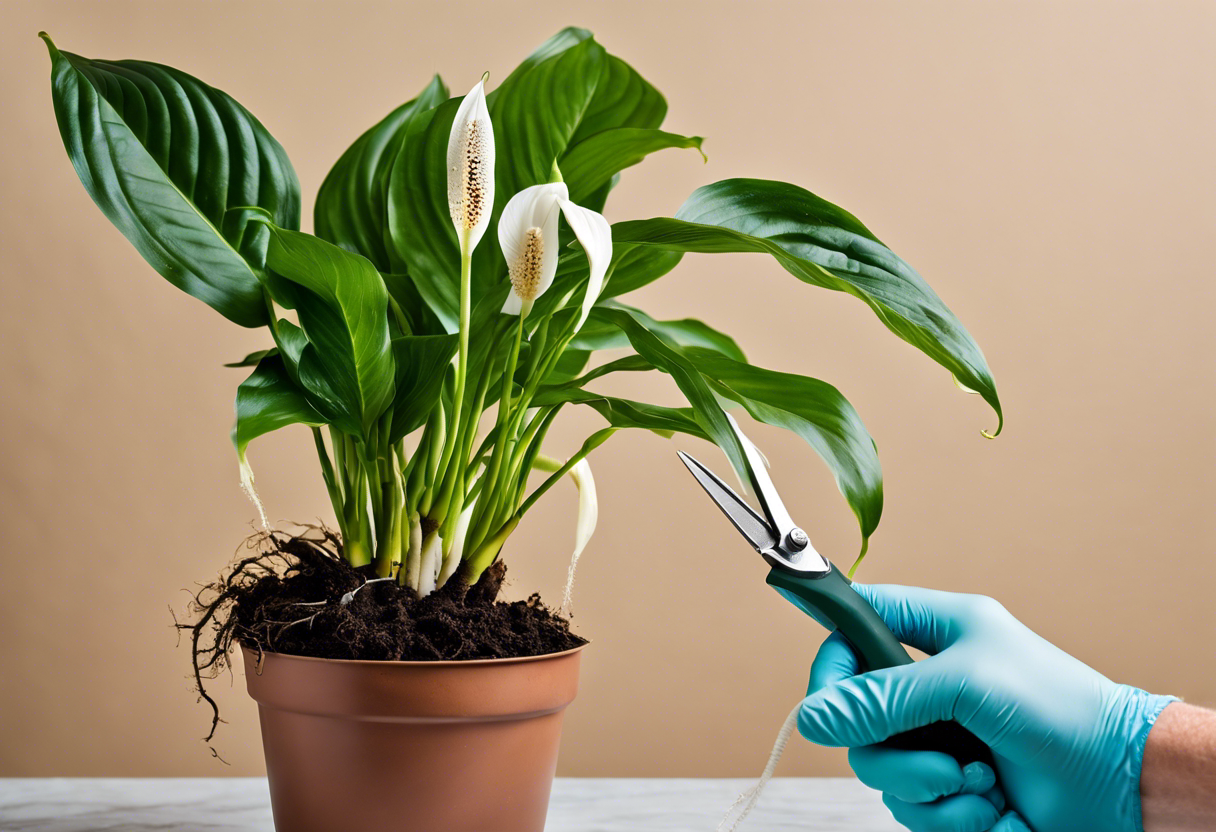Ever found yourself in a panic, thinking, “Oh no! My peace lily is wilting and its leaves are turning yellow!”? Well, I’ve been there too. Your beloved plant might be suffering from root rot. But don’t worry! There’s a way to Save a Peace Lily From Root Rot.
In this blog post, we’re going on a rescue mission together! We’ll learn about the causes of root rot and how you can prevent it from happening again. So buckle up, plant parents! It’s time to save your peace lily from the dreaded root rot. Keep reading about How to Save a Peace Lily From Root Rot?
Key Takeaways
- Identify root rot in a peace lily by yellowing leaves and a foul smell.
- Remove the plant from its pot, gently clean the roots, and trim away any rotten parts.
- Repot the plant in fresh soil, ensuring good drainage to prevent future root rot.
- Water sparingly until the plant recovers, as overwatering is often the cause of root rot.
- Use a fungicide if necessary, but proper care usually prevents recurrence.
Understanding Root Rot in Peace Lilies
Let’s get down to the nitty-gritty of this plant predicament. We’re talking about root rot, a real party pooper for your peace lily. It’s like the uninvited guest that crashes and wreaks havoc.
What is Root Rot?
So, what exactly is this party crasher? Well, root rot is a nasty type of fungal infection that targets the roots of plants. Think of it as a silent assassin, lurking in overly wet soil and striking when you least expect it.
The main culprits behind root rot are poor drainage and overwatering. Yeah, I know, we all love to shower our plants with love (and water), but too much of a good thing can be bad. The excess water creates an ideal environment for fungi to thrive and launch their attack on your plant’s roots.
And boy oh boy, does it wreak havoc! It starts off slow but soon spreads like wildfire, causing the roots to decay and turn mushy. Before you know it, your plant’s looking all droopy and sad – a clear sign something’s not right.
How Does Root Rot Affect Peace Lilies?
Now let’s talk about how root rot plays out in peace lilies specifically. You see, peace lilies are pretty sensitive souls; they don’t take kindly to soggy feet (roots). So when root rot strikes, they react pretty quickly.
One of the first signs you’ll notice is wilting leaves despite regular watering. Your peace lily might also start showing yellow leaves or even brown leaf tips – it’s basically screaming “Help me!” at this point.
If left unchecked, root rot can seriously damage your peace lily’s health – think stunted growth and reduced flowering. In severe cases, it can even lead to plant death! So if you want to save a peace lily from root rot, it’s crucial to catch the symptoms early and take action. Trust me, your peace lily will thank you for it!
Identifying Root Rot in Peace Lilies
To save a Peace Lily from root rot, you gotta catch it early, folks! It’s like catching a cold before it turns into pneumonia. So, let’s dive into the nitty-gritty of Peace Lily care and learn how to spot those pesky root rot signs.
Symptoms of Root Rot in Peace Lilies
Ever seen a peace lily looking more yellow than green? Or maybe its leaves are wilting like an old man on a hot day? These are telltale signs that your plant might be dealing with root rot. Other symptoms include brown leaf tips, mushy roots (yuck!), and soil that smells worse than your gym socks. That’s right, folks – if your peace lily is showing these signs, it might be time to play doctor.
Confirming the Diagnosis of Root Rot
Now don’t go jumping to conclusions just yet! Just because your peace lily has some funky symptoms doesn’t mean it’s got root rot for sure. You need to do a little detective work first. Start by examining the roots – if they’re black or brown and squishier than overcooked pasta, you’ve got yourself a problem. But remember, other issues like overwatering can mimic root rot symptoms too. So make sure you rule out other possibilities before declaring a root rot emergency!
Causes of Root Rot in Peace Lilies
Root rot in peace lilies is often the result of a few common culprits. These include overwatering and poor drainage, inadequate light conditions, and unhealthy soil conditions. Let’s delve deeper into each of these Peace Lily root rot causes.
Overwatering and Poor Drainage
Overwatering your peace lily can lead to waterlogged soil, creating an environment where roots can’t breathe. This suffocation leads to root decay or what we call root rot. The effects of overwatering on Peace Lilies are quite severe as it prevents the roots from absorbing nutrients effectively.
Poor drainage exacerbates this problem by keeping the soil wet for extended periods. This creates a breeding ground for fungi that cause root rot, making it even harder to save a Peace Lily from root rot. So remember folks, don’t drown your peace lily!
Inadequate Light Conditions
Light plays a crucial role in the health of your peace lily. Too little light can lead to weak growth and make your plant more susceptible to diseases like root rot. The light requirements for Peace Lilies aren’t too demanding, but they do need their fair share.
Low light conditions weaken the plant’s immune system making it more prone to infections like root rot. It’s like trying to run a marathon after staying up all night – not gonna end well! So ensure you provide ideal lighting for healthy Peace Lilies.
Unhealthy Soil Conditions
Lastly, let’s talk about soil – the bed where your peace lily sleeps! Unhealthy soil conditions can be detrimental for your plant leading to various problems including root rot.
The right kind of soil helps maintain moisture balance which is crucial for preventing diseases like root rot. If the soil isn’t healthy or well-draining, it could lead to waterlogging and eventually root rot. So, the importance of healthy soil for Peace Lilies cannot be overstated.
Remember, a happy peace lily is one that’s not waterlogged, gets enough light, and sleeps in good soil!
Treating a Peace Lily with Root Rot
So, you’ve got a sick peace lily on your hands. Don’t fret! We’re here to help you save a Peace Lily from root rot. Let’s dive into the nitty-gritty of Peace Lily care and root rot treatment.
Removing the Affected Roots
First things first, we need to identify the culprit – that’s right, those nasty rotten roots. You’ll know them when you see them – they’re usually soft, brown, and well…rotten. It’s like playing surgeon with your plant. But remember, be gentle!
Next up is removing these bad boys without causing more damage to your peace lily. This part can be tricky but don’t worry, it’s all part of proper peace lily root care.
Repotting the Plant
Once you’ve removed the rotten roots, it’s time for a fresh start – repotting your peace lily. The first step is choosing the right pot for your peace lily. Size matters here folks!
Next comes the soil mix for peace lilies. A good rule of thumb is to use a well-draining soil mix because waterlogged soil is a big no-no for these plants.
Using Fungicides for Treatment
Now let’s talk about fungicides as part of treating root rot in peace lilies. These are like the secret weapon in our arsenal against root rot.
Timing is everything when using fungicides on peace lilies. Too early or too late and it could do more harm than good.
Remember folks, prevention is better than cure! Regular use of fungicides can keep root rot at bay and ensure healthy growth for your peace lily.
Preventing Future Root Rot in Peace Lilies
To save a Peace Lily from root rot, it’s essential to focus on prevention. This involves mastering Peace Lily care and understanding the optimal growing conditions for this popular indoor plant.
Proper Watering Techniques
One of the biggest culprits behind root rot is improper watering. Overwatering your peace lily can lead to soggy roots, creating a breeding ground for fungi that cause root rot. On the other hand, underwatering can stress the plant, making it more susceptible to diseases.
The key is finding a balance. A good rule of thumb is to water your peace lily when the top inch of soil feels dry. Remember, it’s better to err on the side of underwatering than overwatering. The quality of water also matters – avoid using cold or hard water as these can shock or harm your plant.
Choosing the Right Soil and Pot
Another crucial aspect of preventing root rot in peace lilies is choosing the right soil and pot. The best soil for peace lilies is well-draining and rich in organic matter. Avoid heavy soils that retain too much water as they can suffocate roots and promote fungal growth.
When it comes to pots, size does matter! Choose a pot that’s just big enough for your plant’s root system – too large, and you risk overwatering; too small, and your plant may become root-bound. Ensure your pot has adequate drainage holes at the bottom to allow excess water to escape.
Ensuring Adequate Light and Temperature
Lastly, maintaining suitable light levels and temperatures plays a significant role in keeping your peace lily healthy and free from root rot. Peace Lilies are not sun worshippers – they prefer indirect light or partial shade over direct sunlight which can scorch their leaves.
As for temperature, these tropical plants thrive in warm conditions between 65-85°F. Avoid placing your peace lily near drafts or cold windows, as sudden temperature drops can stress the plant and make it more susceptible to diseases like root rot.
To Wrap Up
So, we’ve been on a bit of a plant rescue mission, haven’t we? But hey, now you’re equipped with all the tricks to Save a Peace Lily From Root Rot. It’s like being a plant superhero, without the spandex!
Keep those green thumbs ready and remember – your peace lily is counting on you. Let’s keep those roots rot-free!



